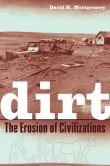F1 hybrid corn is the greediest of plants, consuming more fertilizer than any other crop. Though F1 hybrids were introduced in the 1930s, it wasn't until they made the acquaintance of chemical fertilizers in the 1950s that corn yields exploded. The discovery of synthetic nitrogen changed everything—not just for the corn plant and the farm, not just for the food system, but also for the way life on earth is conducted.
All life depends on nitrogen; it is the building block from which nature assembles amino acids, proteins and nucleic acid; the genetic information that orders and perpetuates life is written in nitrogen ink. But the supply of usable nitrogen on earth is limited. Although earth's atmosphere is about 80 percent nitrogen, all those atoms are tightly paired, nonreactive and therefore useless; the 19th-century chemist Justus von Liebig spoke of atmospheric nitrogen's "indifference to all other substances." To be of any value to plants and animals, these self-involved nitrogen atoms must be split and then joined to atoms of hydrogen.
Chemists call this process of taking atoms from the atmosphere and combining them into molecules useful to living things "fixing" that element. Until a German Jewish chemist named Fritz Haber figured out how to turn this trick in 1909, all the usable nitrogen on earth had at one time been fixed by soil bacteria living on the roots of leguminous plants (such as peas or alfalfa or locust trees) or, less commonly, by the shock of electrical lightning, which can break nitrogen bonds in the air, releasing a light rain of fertility.


No comments:
Post a Comment